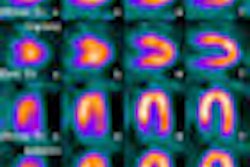ARLINGTON, VA - PET imaging results have changed treatment decisions in more than a third of cancer patients scanned, according to data from a massive new PET registry that is expected to pave the way to expanded Medicare coverage of the modality. The latest results from the National Oncologic PET Registry (NOPR), unveiled last week at the American College of Radiology Imaging Network (ACRIN) fall meeting, show PET's powerful influence in managing a wide variety of cancers.
"Unlike CT and MRI, PET has been prescribed for one cancer at a time for the last dozen years or so," said NOPR investigator Dr. Anthony Shields, Ph.D., a professor of imaging and oncology at Wayne State University in Detroit. But PET providers believe the modality can improve treatment decisions in a wide range of cancers, if patients are carefully selected.
When Shields and his colleagues applied to the U.S. Centers for Medicare and Medicaid Services (CMS) requesting an expansion of covered PET indications, CMS responded with a proposal to pay for PET scans under its "coverage with evidence development" policy, Shields said. The proposal allowed clinicians to be reimbursed for noncovered PET scans for any cancer they deemed appropriate in a patient, as long as they submit a pre-PET and post-PET form that included information on the patient, the cancer, the intended management, and eventually, the results of scanning.
Thus the NOPR was formed in 2006, spearheaded by Dr. Barry Siegel from Washington University School of Medicine in St. Louis, led by principal investigator Dr. Bruce Hillman from Virginia Commonwealth University in Richmond, VA, sponsored by the Los Angeles-based Academy of Molecular Imaging, and managed by ACRIN's statistical office in Philadelphia. The scans are now performed at about 1,700 PET centers across the U.S., Shields said.
NOPR's "primary objective was to assess the overall effect of PET on the intended change in management by a variety of noncovered cancers," he said. "We've also looked at specific tumor types and indications.… You had the physician submit a pretreatment and a post-treatment form, and you didn't get paid until you got that data in."
The postscan form submitted to CMS asks physicians for their current management plan for patients, and the way in which it is to occur. Patients need not consent to PET for the exam to be reimbursed, but they must consent orally for data to be included in registry research, Shields explained. Analysis of the data is aimed at assessing the overall change in management, treatment monitoring, and cancer management, and two early papers have already been published, he said. A third is in press.
"We've got 120,000 patients registered, and data has been submitted on over 100,000 patients," he said. "We basically enroll about 200 patients a day -- numbers none of us have ever seen and will never see again, I suspect." After excluding patients whose PET indications were covered, and those who did not consent to research, approximately 22,000 were included in the latest analysis, Shields said.
Major changes in management
Across a wide spectrum of noncovered malignancies that included cancers of the ovaries, cervix, kidney, prostate, testes, bladder, bone marrow (myeloma), and more, about 20% of patients changed from a nontreatment plan to treatment following PET, Shields said. Conversely, and depending on the cancer, about 5% to 10% of cases were changed from a plan of treatment to nontreatment following PET. Overall, the intended management of 36.5% of cases was changed as a result of PET imaging, he said.
"If you looked at what the pretreatment plan was -- whether imaging, biopsy, watch, or treatment -- the change from imaging, biopsy, or watch [to treatment] was about 20% to 40%," he said. "If they had already planned for treatment, there was a major change in about 9% [to nontreatment]."
The most common cancer by far was prostate, but inasmuch as radiotracer uptake tends to be poor in such cancers except for carefully selected patients, only 3.2% of prostate cancer patients were scanned. Ovarian cancer, where PET is widely considered to be useful, was performed in about a third of these patients.
Overall, post-PET cancer-specific management changes occurred in 44.5% of patients with ovarian cancer; in 40% of patients with brain cancer; in 36.7% of patients with bladder cancer; in 35% of patients with cervical cancer; in 39.3% of patients with pancreatic cancer; in 45%-50% of patients with myeloma; and in 31% of patients with nonmelanoma skin cancer, Shields said. With few cases of testicular cancer in the registry, the data cannot be considered complete for that indication, he added.
Finally, because some physicians listed on the initial form what the intended management would be if PET were not available, these cases were discounted in a separate data analysis, yielding a new "imaging-adjusted change in management" for each cancer, Shields said. Not including this adjustment "underestimates the value of PET, because most of these patients have had a CT or MR before," he said.
Except for myeloma, there was no statistical variability for the management changes across the different cancers, which changed management in about "half of all cancer patients" following the imaging-adjusted management change calculation, he said.
What the data means
The strength of the registry lies not only in its numbers -- it is the largest such effort ever undertaken -- but in its reliance on real-world data from centers across the U.S., Shields said. "And it matches the data from a lot of smaller studies," while including a far wider range of tumor types than previous studies, he said.
As for limitations, the NOPR data represents intended management rather than actual management. How many patients actually underwent the intended management has not been verified for this database, although smaller studies suggest that most clinicians follow through with their management plans, Shields said. Moreover, the study does not address whether PET should be used in lieu of other modalities, nor the optimal sequence of imaging modalties, he said. Finally, whether PET is better than alternative modalties is unknown.
"The change in management care was about a third, whether you look at the overall data or whether you look at a variety of tumor types," he said. We didn't look at whether there was an actual change in management, but we hope to do so in the near future. We looked at a wide variety of cancers and found data that matches quite nicely with ... previously published data," he said.
The researchers are in active discussions with CMS concerning the results and are hoping to see new approved indications for PET in the near future, he added.
"The bottom line was that there was no cancer, that when carefully selected, that PET was not reasonable for," Shields told AuntMinnie.com in an interview after his talk. Even patients with prostate cancer, where FDG uptake is often poor, can be good candidates for PET when the patients are carefully selected in order to answer a specific question, he said. Ovarian cancer is more broadly applicable to PET imaging, but it is the more aggressive cases that tend to be scanned with PET, and patient selection is, again, crucial.
As a result, PET doesn't lend itself to large trials where patients are randomized to receive PET or not, but rather for the individual patient, who, for example, "has got early cancer X, but we've got another lump someplace that may or may not be cancer," he said. "PET can help resolve some of these cases."
Conversely, a higher percentage of ovarian cancer patients get PET, which means that it is probably more generally useful for ovarian cancer, which often metastasizes in the abdomen, Shields said. But PET isn't good for ovarian cancer diagnosis, or even staging unless there is a particular clinical question to answer. What PET is good for is aggressive ovarian cancer.
"Routine CT and MR have a very difficult time finding lumps scattered within the abdomen, and PET does a very good job there," he said. "PET is very useful in ovarian cancer just because of the way it spreads and takes up FDG. That said, if you carefully select your patient with prostate cancer, PET can be useful too. The fraction of prostate cancer patients that can benefit is going to be small, but doctors seem to be choosing them appropriately."
By Eric Barnes
AuntMinnie.com staff writer
October 6, 2008
Related Reading
CMS reconsiders PET coverage framework, September 16, 2008
CMS sets date for PET coverage meeting, August 5, 2008
NOPR asks CMS to expand FDG-PET coverage, April 11, 2008
NOPR study: PET influences cancer care, March 25, 2008
NOPR releases preliminary results of PET treatment strategies, January 11, 2008
Copyright © 2008 AuntMinnie.com




















